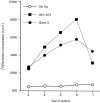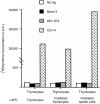Splenic but not thymic autoreactive T cells from New Zealand Black mice respond to a dominant erythrocyte Band 3 peptide
- PMID: 10233746
- PMCID: PMC2326779
- DOI: 10.1046/j.1365-2567.1999.00722.x
Splenic but not thymic autoreactive T cells from New Zealand Black mice respond to a dominant erythrocyte Band 3 peptide
Abstract
Previous work from our laboratory suggested that erythrocyte Band 3 peptide 861-874 is the dominant epitope recognized by splenic T cells from adult New Zealand Black (NZB) mice that are developing autoimmune haemolytic anaemia (AIHA). Here, it is shown that splenic T cells from 6-week-old NZB mice mount a vigorous in vitro proliferative response to peptide 861-874 and some other selected Band 3 peptides. As the donors grow older, splenic T cells respond to an increasing number of Band 3 peptides and the magnitude of their response also becomes greater. Splenic T cells from 3-week-old NZB mice still responded vigorously to peptide 861-874 and Band 3. By contrast, neither thymocytes nor single-positive CD4-enriched thymus cells from NZB mice responded to peptide 861-874 or Band 3, although they responded to concanavalin A (Con A). However, thymocytes from mice expressing a transgenic T-cell receptor (TCR)-specific for myelin basic protein (MBP) peptide Ac 1-9 responded vigorously to Ac 1-9. It is considered that the T-cell response of NZB mice to Band 3 is initially focused on peptide 861-874 and later spreads to other Band 3 peptides as the disease progresses and that peptide 861-874-reactive T cells are primed in the periphery rather than the thymus.
Figures




Similar articles
-
Peptides containing a dominant T-cell epitope from red cell band 3 have in vivo immunomodulatory properties in NZB mice with autoimmune hemolytic anemia.Blood. 2003 Nov 15;102(10):3800-6. doi: 10.1182/blood-2002-07-2125. Epub 2003 Jun 26. Blood. 2003. PMID: 12829598
-
Autoreactive T cell specificity in autoimmune hemolytic anemia of the NZB mouse.Eur J Immunol. 1996 Jan;26(1):136-41. doi: 10.1002/eji.1830260121. Eur J Immunol. 1996. PMID: 8566056
-
Characterization of the dominant autoreactive T-cell epitope in spontaneous autoimmune haemolytic anaemia of the NZB mouse.J Autoimmun. 2002 Mar;18(2):149-57. doi: 10.1006/jaut.2001.0579. J Autoimmun. 2002. PMID: 11908947
-
Deletion of the dominant autoantigen in NZB mice with autoimmune hemolytic anemia: effects on autoantibody and T-helper responses.Blood. 2007 Dec 15;110(13):4511-7. doi: 10.1182/blood-2007-06-094383. Epub 2007 Sep 4. Blood. 2007. PMID: 17785581
-
Modulation of CD4 co-receptor limits spontaneous autoimmunity when high-affinity transgenic TCR specific for self-antigen is expressed on a genetically resistant background.Int Immunol. 2007 Oct;19(10):1235-48. doi: 10.1093/intimm/dxm094. Epub 2007 Sep 5. Int Immunol. 2007. PMID: 17804690
Cited by
-
IL-4 and IL-10 modulate autoimmune haemolytic anaemia in NZB mice.Clin Exp Immunol. 2005 Jan;139(1):84-9. doi: 10.1111/j.1365-2249.2005.02663.x. Clin Exp Immunol. 2005. PMID: 15606617 Free PMC article.
-
Regulatory T cells essential to prevent the loss of self-tolerance in murine models of erythrocyte-specific autoantibody responses.Immunol Res. 2011 Dec;51(2-3):134-44. doi: 10.1007/s12026-011-8259-1. Immunol Res. 2011. PMID: 22131153 Review.
-
T-cell specificity in murine autoimmune haemolytic anaemia induced by rat red blood cells.Clin Exp Immunol. 2002 Aug;129(2):208-13. doi: 10.1046/j.1365-2249.2002.01917.x. Clin Exp Immunol. 2002. PMID: 12165075 Free PMC article.
-
Induction of IL-10 cytokine and the suppression of T cell proliferation by specific peptides from red cell band 3 and in vivo effects of these peptides on autoimmune hemolytic anemia in NZB mice.Auto Immun Highlights. 2017 Dec;8(1):7. doi: 10.1007/s13317-017-0095-4. Epub 2017 Apr 28. Auto Immun Highlights. 2017. PMID: 28455817 Free PMC article.
References
-
- Loutit JF, Mollison PL. Haemolytic icturus (acholic jaundice), congenital and aquired. J Path Bact. 1946;58:711. - PubMed
-
- Sokol RJ, Hewitt S. Autoimmune hemolysis: a critical review. CRC Crit Rev Oncol. 1985;4:125. - PubMed
-
- Helyer BJ, Howie JB. Spontaneous auto-immune disease in NZB/B1 mice. Br J Haematol. 1963;9:119. - PubMed
-
- Deheer DH, Edgington TS. Cellular events associated with the immunogenesis of anti-erythrocyte autoantibody responses of NZB mice. Transplant Rev. 1976;131:116. - PubMed
Publication types
MeSH terms
Substances
Grants and funding
LinkOut - more resources
Full Text Sources
Molecular Biology Databases
Research Materials
Miscellaneous

